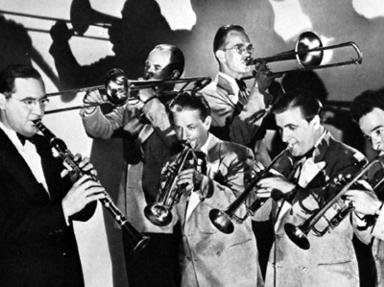Quiz Answer Key and Fun Facts
1. "Like the beat, beat, beat of the tom tom
When the jungle shadows fall
Like the tick, tick, tock of the stately clock
As it stands against the wall
Like the drip, drip, drip of the raindrops
When the summer shower is through
A voice within me keeps repeating
You, you, you"
From what Cole Porter classic will you hear the above lines?
2. In 1934, Harry Warren and Al Dubin wrote a nice little number for the film "Dames". It was a hit at the time for both Ben Selvin and Eddie Duchin. Then much later, cover versions by The Flamingos in 1959 and Art Garfunkel in 1975 had nice runs on Billboard's Hot 100. With the following lyrical hint, what song are we referencing?
"I don't know if we're in a garden
Or on a crowded avenue
You are here, so am I
Maybe millions of people go by
But they all disappear from view"
3. Irving Berlin composed the score and wrote the lyric for this 1937 song with the following lines:
"My heart's on fire and the flame grows higher
So I will weather the storm
What do I care how much it may storm"
What was its title?
4. George and Ira Gershwin collaborated on numerous musical pieces. One from 1937 went like this:
"We may never, never meet again
On the bumpy road to love
But I'll always, always keep the memory of....
The way you hold your knife
The way we danced 'til three
The way you've changed my life"
Can you identify it?
5. Did you know that Charlie Chaplin frequently composed the musical score for his movies? A tune he wrote for his 1936 movie "Modern Times" later had lyrics added in 1954 when Nat "King" Cole recorded the song and scored a top ten hit with it. Of course, It's been recorded countless times since. Do you know it?
"Light up your face with gladness
Hide every trace of sadness
Although a tear may be ever so near
That's the time you must keep on trying
Smile, what's the use of crying
You'll find that life is still worthwhile"
6. Bert Kalmar, Harry Ruby and Oscar Hammerstein II collaborated on the writing of a song in 1935. It seems to have lain dormant for 16 years until it was used in the movie "The Strip" in 1951. Louis Armstrong performed it in the movie and upon its release as a single it managed to chart at Number 16. It's been recorded a multitude of times since but has never been a big hit. Here's the lyrical clue and if you focus on line three, the answer is yours!
"And when I'm alone with my fancies, I'll be with you
Weaving romances, making believe they're true
Oh, give me your lips for just a moment
And my imagination will make that moment live
Give me what you alone can give"
7. "The mere idea of you, the longing here for you
You'll never know how slow the moments go till I'm near to you
I see your face in every flower
Your eyes in stars above"
Ray Noble penned the words and music for this classic in 1934 and his orchestra took it to Number One on the charts that year. Of course, numerous covers have been released since including a Billboard Number 26 hit in 1964 by Ricky Nelson, the last Top 40 solo hit he would have in his recording career. Can you name it?
8. A song, composed in 1937 by Sammy Fain with Irving Kahal contributing the lyrics, was popularized by Bing Crosby in 1944 as an anthem for lovers separated during WWII. It's been a staple of the Great American Songbook ever since. What song featured these lines?
"In every lovely summer's day
In everything that's light and gay
I'll always think of you that way
I'll find you in the morning sun
And when the night is new
I'll be looking at the moon"
9. Written by Rodgers and Hart for their Broadway production of "Babes in Arms" in 1937, it became a Number One chart topper that year for Hal Kemp and his Orchestra, then a Number Three hit for Dion and the Belmonts in 1960. Guess the title of this gem.
"Some things that happen for the first time
Seem to be happening again
And so it seems that we have met before
And laughed before, and loved before
But who knows where or when."
10. The Great American Songbook is filled with entries from the noted composers and lyricists of the past. You know them... the Berlins, the Gershwins and the Cole Porters of the industry. Fewer are authored by the relative unknowns who toiled in Tin Pan Alley over the years. Herman Hupfeld was one of the latter - we know the words, hum the tune but never heard of the man who wrote them. The following slice of lyric comes from his only work that warrants inclusion in "the Book". What memorable song was this?
"Moonlight and love songs never out of date
Hearts full of passion, jealousy and hate
Woman needs man and man must have his mate
That no one can deny"
Source: Author
maddogrick16
This quiz was reviewed by FunTrivia editor
1nn1 before going online.
Any errors found in FunTrivia content are routinely corrected through our feedback system.

